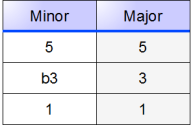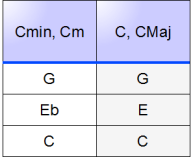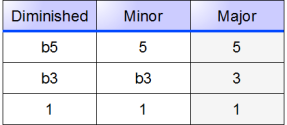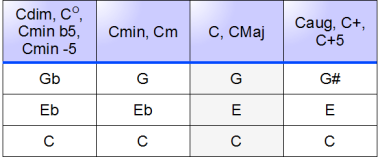Introduction To Chords
This next section on chords is written with the assumption that you have a working knowledge of intervals (major, minor, augmented, diminished, and perfect).
A Chord is a musical structure comprised of three or more tones. Simple Chords, made up of only three notes, are what we will focus on in this section. They can be either Major, Minor, Diminished, or Augmented. There are more complex chords, consisting of four or more notes, but we will discuss those in a later section.
Major Chords
When forming a Major chord, one must temporarily think in the key of the root of that chord. The Root of the chord is where we get the letter name for the chord. It is also the note by which all other notes in that chord are determined. The other two notes of the chord are taken from the scale tones a third and fifth above the root. These three notes form a Major chord.
As an example, let us form an E Major chord.
- The name of the chord gives us the root, that is, E.
- We know that the key of E Major has four sharps: F#, C#, G#, and D#. The E Major scale, then, is E, F#, G#, A, B, C#, D#, and E.
- We now take the third and fifth from this scale, together with the root, and form the E Major chord.
- Therefore, the notes E, G#, and B make up the E Major chord.

E Major Chord from an E Major Scale |
Let us follow this procedure again to form an Ab Major chord.
- The name of the chord gives us the root, that is, Ab.
- We know that the key of Ab Major has four flats: Bb, Eb, Ab, and Db. The Ab Major scale, then, is Ab, Bb, C, Db, Eb, F, G, and Ab.
- We now take the third and fifth from this scale, together with the root, and form the Ab Major chord.
- Therefore, the notes Ab, C, and Eb make up the Ab Major chord.
 Ab Major Chord from an Ab Major Scale |
Using this system, one can find any Major chord. Most people instantly realize, however, that it takes a lot of thought to figure out a Major chord in this manner, and is impractacle for use while playing. They are right. This only serves to explain the reason as to why a Major Chord is called a Major Chord (because it is based upon the Major scale of the root). From this point, you should strive to memorize all the major chords, so that you may have them instantly at your finger tips. Then, you will find it easy to make other types of chords.
We will now begin to create a chart which will help us see how the Major chord relates to all other chords. It begins quite simply:

The 1, 3 and 5 refer to the root, third and fifth (respectively) of the scale from which the chord is based. An example of this chart being applied to a C chord is shown below, along with the common abbreviations used to describe that chord.

Minor Chords
Once a major chord has been established, a Minor chord is just one step away. Simply take any Major chord, and lower its third one half step.
Let's make a Bb Minor chord.
- Find the notes of the Bb Major chord (Bb, D, and F).
- Lower the third one half step, turning the D into a Db.
- Therefore, the notes Bb, Db, and F make up a Bb Minor chord.
 Bb Maj to Bb Min |
Let us follow the same procedure again to make an A Minor chord.
- Find the notes of the A Major chord (A, C#, and E).
- Lower the third one half step, turning the C# into C (C natural).
- Therefore, the notes A, C, and E make up an A Minor chord.
 A Maj to A Min |
Let us now add to our chart, to show both the Major and Minor chord constructs. Notice that, by simply changing one note, one can form a Minor chord from any Major chord, and vice versa. Also notice that the column representing the Major chord, the basis for all other chords, is shaded for easy identification. The Minor column is placed on the left side of the Major column, to illustrate the "falling" nature of the third of the chord.

Here is the same chart as it would appear using a C Chord.

Diminished Chords
Once a minor chord has been established, a Diminished chord is just one step away. Simply take any Minor chord, and lower its fifth one half step. In the same vein of thought, a Diminished chord is only two steps away from a Major chord. Just take a Major Chord, and lower both the third and the fifth one half step, and you're there!
Let's make a D Diminished chord.
- Find the notes of the D minor chord (D, F, and A).
- Lower the fifth one half step, turning the A into a Ab.
- Therefore, the notes D, F, and Ab make up a D Diminished chord.
 D Min to D Dim |
- Find the notes of the D Major chord (D, F#, and A).
- Lower the third one half step, turning the F# into F, and lower the fifth one half step, turning the A into a Ab.
- Using either process (beginning with a Major chord, or beginning with a Minor chord) results in the same notes, D, F, and Ab, and make up a D Diminished chord.
 D Maj to D Dim |
Let us follow the same procedure to make an Eb Diminished chord.
- Find the notes of the Eb minor chord (Eb, Gb, and Bb).
- Lower the fifth one half step, turning the Bb into a Bbb (yes, this is a double flat).
- Therefore, the notes Eb, Gb, and Bbb make up an Eb Diminished chord.
 Eb Min to Eb Dim |
- Find the notes of the Eb Major chord (Eb, G, and Bb).
- Lower the third one half step, turning the G into Gb, and lower the fifth one half step, turning the Bb into a Bbb.
- Using either process (beginning with a Major chord, or beginning with a Minor chord) results in the same notes, Eb, Gb, and Bbb, and make up an Eb Diminished chord.
 Eb Maj to Eb Dim |
Let us now add the Diminished chord construct to our chart. Again, notice how closely related all the chords are, and how simply one can be formed, based on the notes from another.

And here is the chart, as applied to the C chord:

Augmented Chords
The Augmented chord is the final of these "simple," three note chords. Like the Minor and Diminished, it is also just a step away from the Major chord. To augment means to increase, so to make an Augmented chord, simply take any Major chord, and raise its fifth one half step.
Let's make a F Augmented chord.
- Find the notes of the F Major chord (F, A, and C).
- Raise the fifth one half step, turning the C into a C#.
- Therefore, the notes F, A, and C# make up a F Augmented chord.
 F Maj to F Aug |
Let us follow the same procedure again to make a B Augmented chord.
- Find the notes of the B Major chord (B, D#, and F#).
- Raise the fifth one half step, turning the F# into Fx (F double-sharp).
- Therefore, the notes B, D, and Fx make up a B Augmented chord.
 B Maj to B Aug |
Here is the final addition to our simple chart. Notice that the Augmented chord is placed to the right the Major chord, reflecting the "raised" character of its construction. Similarly, the Minor and Diminished chords are placed to the left of the Major chord, because of the "falling" nature of their thirds and fifth.

Here is the chart as applied to a C chord:
